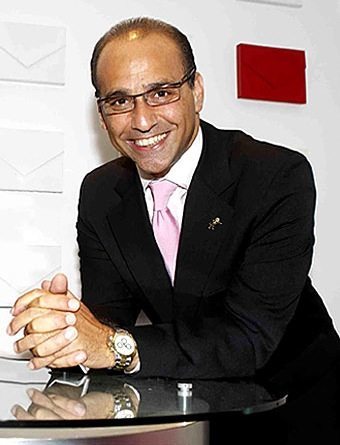Entrepreneurs
Why Theo Paphitis Is So Successful
Theo Paphitis is one of the best known business magnates in the retail sector. He gained national fame in the UK by appearing on the BBC business programme Dragons’ Den.
Paphitis has made a large proportion of his fortune through the famous lingerie brand La Senza as well as investments across a multitude of industries.
Theo Paphitis’ Early Life
 Cyprus born Paphitis showed his business skills at an early age after his family emigrated to the UK. At the tender age of fifteen he successfully managed the Tuck Shop at his school in London. His first job was a ‘tea boy’ and filing clerk at a City of London Insurance Broker. His desire to improve his finances led him to discover his passion and skills in retail sales when he worked selling watches for Watches of Switzerland on the famous Bond Street in London. Paphitis then moved into property and finance when, at the still young age of twenty three, he set up his own company.
Cyprus born Paphitis showed his business skills at an early age after his family emigrated to the UK. At the tender age of fifteen he successfully managed the Tuck Shop at his school in London. His first job was a ‘tea boy’ and filing clerk at a City of London Insurance Broker. His desire to improve his finances led him to discover his passion and skills in retail sales when he worked selling watches for Watches of Switzerland on the famous Bond Street in London. Paphitis then moved into property and finance when, at the still young age of twenty three, he set up his own company.
Theo Paphitis’ estimated net worth is $324 Million.
Theo Paphitis the Entrepreneur
 When Paphitis’ business partner and friend left their property finance company, he kept going and made his first money when the commercial property market rose in the eighties. Paphitis then noticed the rise of mobile telephones and he bought into NAG Telecom and became chairman. The company gained a large market share through Paphitis’ negotiations with Ryman stores to secure concessionary positions.
When Paphitis’ business partner and friend left their property finance company, he kept going and made his first money when the commercial property market rose in the eighties. Paphitis then noticed the rise of mobile telephones and he bought into NAG Telecom and became chairman. The company gained a large market share through Paphitis’ negotiations with Ryman stores to secure concessionary positions.
When Ryman filed for bankruptcy, Paphitis purchased the company. He then improved relationships with suppliers, motivated the management team and turned the company around. This confirmed his now growing reputation for taking failing companies and turning them into profitable ones. Paphitis also co-owns Red Letter Days with fellow ‘TV Dragon’, Peter Jones and he sold his equity stake in the global lingerie brand La Senza for more than $150 Million in 2006.
Keen to return to the lingerie business, Paphitis set up a new chain, Boux Avenue that grew to more than twenty stores within two years. In the summer of 2012, the homewares specialist chain, Robert Dyas joined Paphitis’ retail portfolio after the company ‘fitted his investment criteria’. This has taken the combined size of Paphitis’ empire to 349 stores and 3,600 employees, serving in excess of twenty eight million customers every year.
“There’s not much difference between a fantasist and a visionary. We all have dreams and without dreams in business, I don’t believe you can be successful. The trick is to turn them into reality.” – Theo Paphitis
Theo Paphitis’ Business Philosophy
 Paphitis is a self-confessed fan of ‘common sense’ in business, in fact, he believes that it is the key to his success. Paphitis regularly repeats the famous business school motto “KISS – Keep It Simple Stupid” and says that there are 3 reasons to be in business, “To make money, to have fun and to make money’.
Paphitis is a self-confessed fan of ‘common sense’ in business, in fact, he believes that it is the key to his success. Paphitis regularly repeats the famous business school motto “KISS – Keep It Simple Stupid” and says that there are 3 reasons to be in business, “To make money, to have fun and to make money’.
Paphitis is an avid supporter of small and up and coming businesses. He even runs a weekly competition on social media (#SBS or Small Business Sunday) where businesses compete to have a message retweeted by his personal account.
“One of the things I preach to all my staff is never be frightened to make a decision.” – Theo Paphitis
Theo Paphitis on TV
 Whilst chairman of Millwall Football Club, Paphitis appeared on BBC series, Back to the Floor. As a result of this, he was asked to appear in the second series of Dragons’ Den. Paphitis appeared on the show for seven years before leaving in 2012. Paphitis made many investments in the startup companies featured on the programme and he became loved for his straight talking and approachable demeanour.
Whilst chairman of Millwall Football Club, Paphitis appeared on BBC series, Back to the Floor. As a result of this, he was asked to appear in the second series of Dragons’ Den. Paphitis appeared on the show for seven years before leaving in 2012. Paphitis made many investments in the startup companies featured on the programme and he became loved for his straight talking and approachable demeanour.
Paphitis has alos made several other TV appearances outside of Dragons’ Den including Theo’s Adventure Capitalists, and Britain’s Next Best Thing for the BBC and The Agenda for ITV.
Theo Paphitis’ Charity Work
The Paphitis Charitable Trust takes Theo Paphitis’ fees from his media appearances, his speeches and his book and distributes them to charities close to his heart, most of which are children’s charities. He has also teamed up with his 2,200 colleagues at Ryman and raised in excess of $2 Million for UK Charity Comic Relief, aiming to tackle many issues nationally and internationally.
Theo Paphitis’s Advice
Conclusion
Theo Paphitis found his passion, developed that passion and succeeded at that passion. An ability to spot an opportunity to turn a business around, to get into a business or to sell a business has made Theo Paphitis hundreds of millions of dollars. It is amazing how he has always been able to squeeze every bit of juice out of every opportunity and remain ready for the next one.
As Theo Paphitis continues to build his portfolio and his personal brand, he still finds the time to help small businesses in an inspirational manner.
The main lesson that we can learn from Theo Paphitis is to take advantage of an opportunity when the time is right and work hard enough to make success inevitable.
Business
The Hidden Money Pit in Your Operations (and How to Use It)
See how smart asset management software is quietly saving businesses thousands in wasted time, stock, and maintenance.

Trimming unnecessary expenses and minimizing resources is a general practice in running a business effectively. Asset management software can help you achieve those goals. (more…)
Business
Thinking of Buying A Business? These 6 Sectors Quietly Produce the Best Deals
Before you buy your next venture, check out the sectors where successful businesses are changing hands every day.

All entrepreneurs have a desire to be the masters behind a successful venture. Buying an established business is a great choice for many. This provides instant access to an established market with existing infrastructure and clients. (more…)
Business
The Entrepreneur’s Reading List That Transforms Ideas Into Empires
These must-read titles and writing insights reveal how entrepreneurs turn bold ideas into empire-level success.

Entrepreneurship is powered by stories—of accomplishment, failure, and decision moments that define businesses. Books are maps, providing insight from individuals who’ve traversed the road ahead. (more…)
Entrepreneurs
The Leadership Shift Every Company Needs in 2025
Struggling to keep your team engaged? Here’s how leaders can turn frustrated employees into loyal advocates.

In workplaces around the world, there’s a growing gap between employers and employees and between superiors and their teams. It’s a common refrain: “People don’t leave companies, they leave bad bosses.”
While there are, of course, cases where management could do better, this isn’t just a “bad boss” problem. The relationship between leaders and employees is complex. Instead of assigning blame, we should explore practical solutions to build stronger, healthier workplaces where everyone thrives.
Why This Gap Exists
Every workplace needs someone to guide, supervise, and provide feedback. That’s essential for productivity and performance. But because there are usually far more employees than managers, dissatisfaction, fair or not, spreads quickly.
What if, instead of focusing on blame, we focused on building trust, empathy, and communication? This is where modern leadership and human-centered management can make a difference.
Tools and Techniques to Bridge the Gap
Here are proven strategies leaders and employees can use to foster stronger relationships and create a workplace where people actually want to stay.
1. Practice Mutual Empathy
Both managers and employees need to recognize they are ultimately on the same team. Leaders have to balance people and performance, and often face intense pressure to hit targets. Employees who understand this reality are more likely to cooperate and problem-solve collaboratively.
2. Maintain Professional Boundaries
Superiors should separate personal issues from professional decision-making. Consistency, fairness, and integrity build trust, and trust is the foundation of a motivated team.
3. Follow the Golden Rule
Treat people how you would like to be treated. This simple principle encourages compassion and respect, two qualities every effective leader must demonstrate.
4. Avoid Micromanagement
Micromanaging stifles creativity and damages morale. Great leaders see themselves as partners, not just bosses, and treat their teams as collaborators working toward a shared goal.
5. Empower Employees to Grow
Empowerment means giving employees responsibility that matches their capacity, and then trusting them to deliver. Encourage them to take calculated risks, learn from mistakes, and problem-solve independently. If something goes wrong, turn it into a learning opportunity, not a reprimand.
6. Communicate in All Directions
Communication shouldn’t just be top-down. Invite feedback, create open channels for suggestions, and genuinely listen to what your people have to say. Healthy upward communication closes gaps before they become conflicts.
7. Overcome Insecurities
Many leaders secretly fear being outshone by younger, more tech-savvy employees. Instead of resisting, embrace the chance to learn from them. Humility earns respect and helps the team innovate faster.
8. Invest in Coaching and Mentorship
True leaders grow other leaders. Provide mentorship, career guidance, and stretch opportunities so employees can develop new skills. Leadership is learned through experience, but guided experience is even more powerful.
9. Eliminate Favoritism
Avoid cliques and office politics. Decisions should be based on facts and fairness, not gossip. Objective, transparent decision-making builds credibility.
10. Recognize Efforts Promptly
Recognition often matters more than rewards. Publicly appreciate employees’ contributions and do so consistently and fairly. A timely “thank you” can be more motivating than a quarterly bonus.
11. Conduct Thoughtful Exit Interviews
When employees leave, treat it as an opportunity to learn. Keep interviews confidential and use the insights to improve management practices and culture.
12. Provide Leadership Development
Train managers to lead, not just supervise. Leadership development programs help shift mindsets from “command and control” to “coach and empower.” This transformation has a direct impact on morale and retention.
13. Adopt Soft Leadership Principles
Today’s workforce, largely millennials and Gen Z, value collaboration over hierarchy. Soft leadership focuses on partnership, mutual respect, and shared purpose, rather than rigid top-down control.
The Bigger Picture: HR’s Role
Mercer’s global research highlights five key priorities for organizations:
-
Build diverse talent pipelines
-
Embrace flexible work models
-
Design compelling career paths
-
Simplify HR processes
-
Redefine the value HR brings
The challenge? Employers and employees often view these priorities differently. Bridging that perception gap is just as important as bridging the relational gap between leaders and staff.
Treat Employees Like Associates, Not Just Staff
When you treat employees like partners, they bring their best selves to work. HR leaders must develop strategies to keep talent engaged, empowered, and prepared for the future.
Organizational success starts with people, always. Build the relationship with your team first, and the results will follow.
-

 Change Your Mindset4 weeks ago
Change Your Mindset4 weeks agoWork-Life Balance Isn’t a Myth: Here’s How to Actually Make It Happen
-

 Change Your Mindset4 weeks ago
Change Your Mindset4 weeks agoThe Four Types of Happiness: Which One Are You Living In?
-

 Life3 weeks ago
Life3 weeks ago9 Harsh Truths Every Young Man Must Face to Succeed in the Modern World
-

 Success Advice3 weeks ago
Success Advice3 weeks agoInside the TikTok Resume Hack That’s Fooling Recruiters (For Now)
-

 Change Your Mindset2 weeks ago
Change Your Mindset2 weeks agoThe One Leadership Habit That Separates the Great From the Forgettable
-

 Personal Development2 weeks ago
Personal Development2 weeks agoThis Silent Habit Might Be Sabotaging Your Career
-

 Business1 week ago
Business1 week agoWhy Your E-Commerce Fulfilment Is Probably Broken (And How to Fix It)
-

 Shift Your Mindset4 days ago
Shift Your Mindset4 days ago11 E’s That Define Every Great Leader And Why Most People Miss Them


























